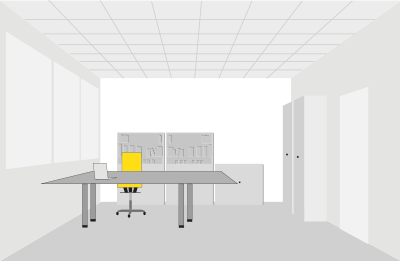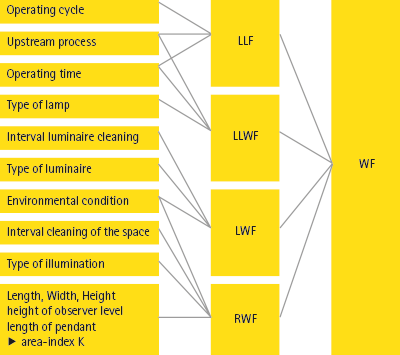3. LIGHTING PLANNING
The planning of a lighting system represents a complex task, including the working out of a lighting solution together with the building owner, the architect and the building services planner. This should fulfill valid standards and directives and should also meet the quality attributes for good lighting (see Section 4). And of course, successful lighting design in combination with the interior design also contributes to pleasant spacial environments.
3.1 PREREQUISITES
The following documents and specifications are necessary for planning a lighting system:
- Floor plan and sections of the rooms, room dimensions
- Ceiling system (type of construction and ceiling axis dimensions)
- Colours, reflection factors of ceiling, walls, floor and furniture
- Furniture or machine layouts
- Room use and visual tasks
- Position of work areas and surrounding areas
- Operating conditions such as temperature, dust and humidity

3.2 STANDARDS
Lighting systems should comply to valid standards and directives. The basis for this is supplied by the European EN 12464 standard, ‚Lighting of workplaces‘.
3.2.1 EN 12464 Part 1 ‚Lighting of workplaces in indoor areas‘
Extract from DIN EN 12464-1
The indicated maintenance values for the illuminance are mean values above the working zone on the horizontal, vertical or inclined reference area. Independent of age and condition of the lighting system, the mean illuminance may not fall below the indicated value.
The UGR value of a lighting system may not exceed the indicated value.
Revision DIN EN 12464-1
The standard is currently being revised, the new version is expected to be published in Autumn 2021. The illuminance levels shown in the following table are supplemented in the new version by further, higher illuminance levels. This gives planners more freedom to do justice to sensitive lighting tasks.
3.2.2 Further standards and directives
EN 1838 Emergency lighting
EN 12193 Sport hall lighting
EN 15193 Energy-related evaluation of buildings
BSI LG 7 Lighting Guide 7: Office Lighting
DIN 5035 Lighting with artificial light
DIN 67528 Lighting in public car-parks and on public off-street parking spaces
DIN SPEC 67600 Biologically effective lighting - planning recommendations
DIN V 18599 Energy-related evaluation of buildings
ASR 7/3 Workplace directive
BGR 131 Employers‘ association
Guidelines from specialist associations
3.3 SPECIAL REQUIREMENTS
According to the application area, special operating conditions must be taken into account when selecting luminaires. The following represents a selection of frequent requirements.
3.3.1 Higher protection ratings
Some of the most frequent strains on electrical control gear are dust and humidity. In rooms with such conditions, luminaires with higher protection ratings must be used that are designed to prevent the ingress of foreign bodies and/or water (see Fig. 8.6.).
3.3.2 Fire risk facilities
This concerns rooms where a danger exists of flammable materials coming into proximity with electrical operating devices, meaning that fire may result. In situations with danger of fire via dust and/or fibres, luminaires must comply with the minimum protection rating of IP50 and the D designation (see Fig. 8.6.). In such cases the temperatures of the luminaire surfaces where with correct mounting flammable materials may gather must not exceed specified limit values.
3.3.3 High or low ambient temperatures
Luminaires are inspected in laboratory conditions with standardised parameters.Ambient temperature is usually 25°C. If in practice the ambient temperature strongly differs from this (e.g. for cold stores or workshops with process heat) the luminaire manufacturer should be consulted. In some cases special measures must be carried out.
3.3.4 Resistance to aggressive materials
If aggressive materials in the room atmosphere exist for specific application areas, the luminaire manufacturer should be consulted in order to assess the suitability of the luminaires. In this case information concerning the type of materials, their concentrations in the ambient air, ambient temperature and air humidity should be given. With regard to the compatibility of plastics to chemicals see Fig. 8.2.4. In this connection, resistance to chemical cleaning solvents must also be ascertained.
3.3.5 Splinter protection
Both in sensitive production areas and especially in rooms used for foodstuff manufacturing, impurities via glass splinters (e.g. from lamp damage) must be prevented. For this reason lamps with protective tubing or closed luminaires should be used.
3.3.6 Increased safety requirements in the food industry
Particular strict criteria apply for the use of luminaires in rooms of the food and beverage industry. Along with a higher degree of protection, the focus is on shatter protection, mechanical and chemical resistance as well as aspects of cleaning and/or maintenance. Appropriate tests according to DIN 10500 need to be performed to prove that these luminaires satisfy the standard IFS Food (International Featured Standards Food, formerly International Food Standard) and/or the BRC-Global Standard Food (British Retail Consortium) and may therefore be used in companies certified according to these standards.
3.3.7 Protection against flying balls
In sports halls, balls collide with luminaires with a relatively high impact velocity. Here it must be guaranteed that lamps are not destroyed by the impact and that no danger for people occurs from falling pieces. Luminaires for sports halls must therefore be ball-proof (see Fig. 8.6.).
3.3.8 Suitability for computer workstations
In rooms with computer screens, non-computer screen compatible lighting can lead to reflections and therefore glare. Lighting planning must therefore determine the area for luminaire mounting that may lead to disturbances, and the type and arrangement of luminaires must be selected in such a way that no disturbing reflections are created. Computer screen-compatible luminaires are equipped with special lighting technology with which the luminance values in the critical angle areas are reduced (see Fig. 4.3.).
3.3.9 Further demands for colour rendition
Various colour rendering properties of lamps lead to different perception of colours, thus influencing visual performance and well-being. Natural colour rendition is especially important for visual tasks in which colours must be matched and controlled (e.g. dental laboratories, printing works, textile manufacturing and sales). In this regard, suitable lamps with optimal colour rendition should be used.
3.3.10 Clean rooms
Clean room technology protects products, processes and people from the hazardous effects of contamination. That is why high quality requirements are placed on the operating resources (incl. illuminants), such as a reduction of particle emissions. Clean room applications are, for example, found in hospitals, in the pharmaceutical and foodstuff industries, in microelectronics and in research laboratories.
3.4 MAINTENANCE FACTOR
Illuminance levels specified in EN 12464 are so-called maintenance values and must not be fallen short of. Because in practice the actual illuminance level decreases due to ageing and soilage of the lamps, luminaires and the rooms, this is compensated for with the calculation of a maintenance factor (see Fig. 4.1). It is the duty of the lighting planner to specify or calculate the maintenance factor for the specific room and to draw up a maintenance plan. Mathematically, the maintenance factor represents the product of four part-maintenance factors:
WF=LLWF x LLF x LWF x RWF
LLF Lamp service life factor
(lamp failure during service life)
LLWF Lamp luminous flux maintenance factor
(reduction of luminous flux during service life)
LWF Luminaire maintenance factor
(soiling of luminaires between two cleaning cycles)
RWF Room maintenance factor
(reduction of reflection factors of the room surfaces)
WF Maintenance factor
